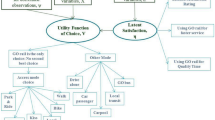Abstract.
We show that enriching logit mode choice model specification by mode attributes, socio economic variables and trip purpose characteristics significantly improves model quality, and that Box-Cox transformations applied to model attributes imply an asymmetry of the reaction curve, as well as more reasonable properties (diminishing marginal values of time savings, elasticities and values of time that differ among the modes) than those of the linear logit model. Moreover, the model yielded very different high speed rail market shares for Germany than results obtained with the usual linear utility functions.
Similar content being viewed by others
Author information
Authors and Affiliations
Additional information
Received: December 1996 / Accepted: April 1997
Rights and permissions
About this article
Cite this article
Mandel, B., Gaudry, M. & Rothengatter, W. A disaggregate Box-Cox Logit mode choice model of intercity passenger travel in Germany and its implications for high-speed rail demand forecasts. Ann Reg Sci 31, 99–120 (1997). https://doi.org/10.1007/s001680050041
Issue Date:
DOI: https://doi.org/10.1007/s001680050041



